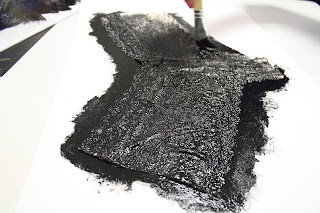Collagraphy is a printmaking process in which materials are applied to a rigid surface (such as paperboard or wood). The word is derived from the Greek word koll or kolla, meaning glue and graph, meaning the activity of drawing.Substances such as carborundum, acrylic texture mediums, sandpapers, string, cut card, leaves and grasses can all be used in creating the collograph plate.
The plate can be intaglio-inked, inked with a roller or paintbrush. Ink or pigment is applied to the collage, and the board is used to print onto paper or another material using either a printing press or various hand tools. The resulting print is termed a collagraph.
(The year 12 project is based on 'Collections' and they are taking
their inspiration from clothes, hence the underwear!)
Different tonal effects and vibrant colours can be achieved with the technique due to the depth of relief and differential inking that results from the collagraph plate's highly textured surface. Collagraphy is a very open printmaking method. Ink may be applied to the upper surfaces of the plate with a brayer for a relief print, or ink may be applied to the entire board and then removed from the upper surfaces but remain in the spaces between objects, resulting in an intaglio print. A combination of both intaglio and relief methods may also be employed.
The new Hawthorn 405 etching press in action






No comments:
Post a Comment
Note: only a member of this blog may post a comment.